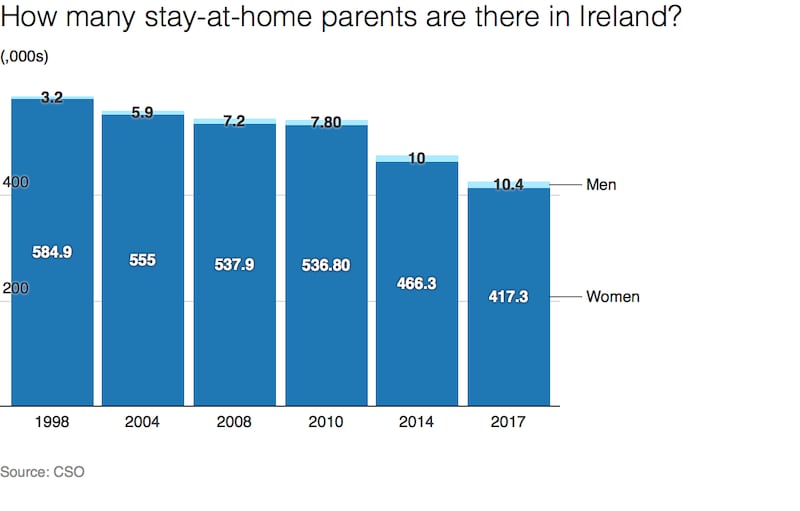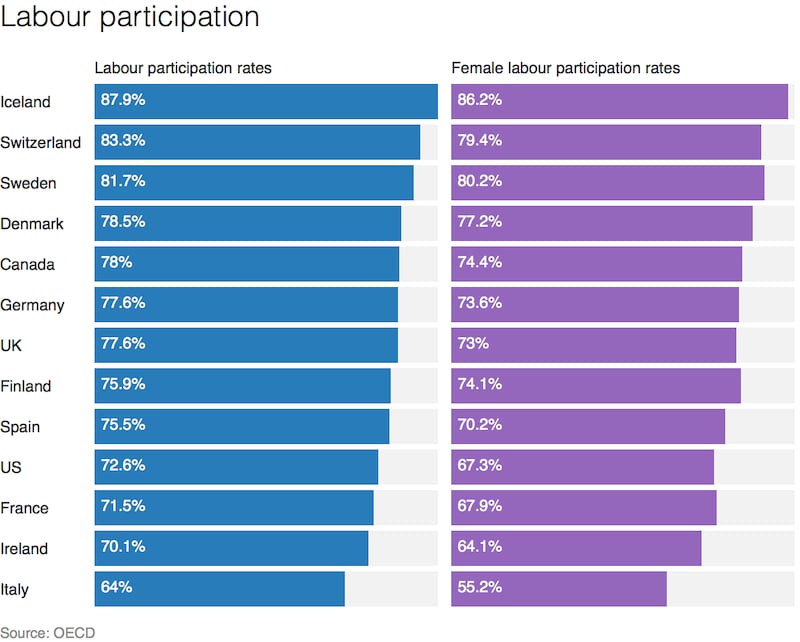Irish girls outperform boys in most subjects in the Leaving Certificate; in professional exams, such as accountancy, females are again to the fore; and data shows that up to the age of about 30, women keep pace with men in the workforce.
And yet, after that, a hefty gap opens up, with just 64 per cent of women working compared with more than 70 per cent of men. While there are obvious workplace factors at play in these figures, what might surprise is just how much wider the gap is in Ireland than in many other western economies.
Irish women continue to lag significantly their international peers, with a little more than three out of five women working here, compared with as many as almost nine in 10 in countries such as Iceland.
A World Economic Forum (WEF) gender gap report from last year placed Ireland top of the table for educational attainment, indicating that there is no difference in terms of education for both men and women. However, when it came to economic participation and opportunity, Ireland slumped to 49th, due to lower female participation rates and lower average earnings for women.
As the WEF report notes, a large number of countries – Ireland included – “have failed to reap the returns on a pool of highly educated and skilled women”.
Women have been told they can have it all. So they outperform at school and at college, set themselves ambitious goals, and then find themselves set adrift when it comes to having families and working. So what’s going on? And if companies’ workplace strategies are global, what makes Ireland so different?
Participation rates
Compared with other OECD countries, Irish women undoubtedly work less. In Iceland, for example, some 86 per cent of women work, while in Sweden the figure is 80 per cent and it’s 74 per cent in Canada. In Ireland, the figure is as low as 64.1 per cent, and it’s not alone at the bottom of the table. The United States also has a participation rate of less than 70 per cent, while in Italy only about one in two women work.
It means that Ireland has greater numbers of stay-at-home parents than many other countries. That’s not to suggest that a large number of stay-at-home parents isn’t a welcome facet of Irish society. Staying at home to care for children or elderly parents is as valid a choice as going to out to work is, and women who stay at home play a huge role both in rearing families and in contributing to local communities.
The difference perhaps is that, for many Irish parents, the “choice” is impacted by various characteristics of the Irish economy that are not present in other countries.
Facilitating women to stay in the workforce – and then them choosing to stay at home is one thing. Making it very difficult for them to stay at work is quite another.

And while some progress has been made, staying at home to care for children still remains largely – if not exclusively – a female pursuit. Back in 1986, for example, some 653,398 Irish women classed their economic status as “looking after home/family”, with just 445 men staying at home. That’s about 1,460 stay-at-home mums for every one stay at home father.
Fast forward to 2017, however, and the number of women looking after family has shrunk by 36 per cent to 417,300, while the number of men minding the home has soared to 10,400, but it still means that for every stay at home father, there are 40 female equivalents.
Alongside other countries with low female participation rates, such as Italy and Portugal, Irish women also work a greater number of unpaid minutes in a day, compared with those in Sweden, Norway and France.
Childcare costs
For many Irish families, it simply doesn’t pay to have two parents working.
There appears to be some correlation between high childcare costs and lower female labour participation rates. OECD figures from last year show that an Irish family on 167 per cent of average earnings – a combined salary of about €75,000 – will give up, on average, 27 per cent of their after-tax income on childcare costs, or about €1,177 a month.
Contrast that with the experience in Austria, where a family will spend just 2.7 per cent on childcare (€112), or France, where they’d lose 9.7 per cent (€422), thanks to state-subsidised childcare.
It should be noted that a direct comparison is difficult. Tax rates may be higher and child benefit may be lower in other countries. But the depth of the gap between Ireland and these other countries is significant however you look at it.
When it came to following “Boston or Berlin”, Ireland, it seems, has very much chosen the US way – where childcare costs are about 26 per cent of net salary.
While there have been some welcome efforts of late to address this gap, the recently introduced Affordable Childcare scheme is still way off the mark at making a realistic dent on families’ childcare costs.
Also, where free childcare is available – such as through the Early Childhood Care and Education scheme, which typically offers about three hours a day – the hours are limited. Contrast this with the experience of Iceland, where Leikskóli is attended by children on a full-time basis, and starts at the age of one-and-a-half or two up until school starts at age six. Again, it’s not about saying working outside or inside the home is better; it’s about giving women a real choice.
Fathers’ participation
There is no doubt that today’s generation of fathers is much more involved in the home than their fathers ever were, with some 10,000 or so even opting to take on the care of their family themselves. Most school gates will have a decent split in terms of who’s dropping off and collecting – at least in the mornings. However, it’s possibly not enough yet, and Government policy is still falling short in this regard.
Figures show that the countries with the highest number of women in the workforce also tend to have greater shared leave for both fathers and mothers.
Here in Ireland, fathers are finally entitled to paternity leave. But at just two weeks, paid at a rate of €235 a week (unless employers top it up), it’s unlikely to make significant inroads just yet.
The example of US multinationals, such as Facebook and Google, which offer fathers up to four months’ paid paternity leave, may eventually start to trickle down. However, that’s leaving it up to the private sector, which may not be the best solution.

In Iceland, for example, every parent receives three months’ paid leave that is non-transferable. Parents then have an additional three months to share as they like. Other Scandinavian countries have similarly progressive approaches.
Sometimes, however, it’s not just regulations that need to change, it’s culture too.
In the UK, shared parental leave was introduced in April 2015 to help women stay and progress in the workforce. But figures show that fewer than 1 per cent of those eligible have taken advantage of the leave, with the blame lying on affordability and the scheme’s restrictiveness. Fathers are typically eligible for fully paid leave only in the 20 weeks following the birth – a time when many mothers may be reluctant to leave their newborn.
The “stigma” of being a stay-at-home father, and the fear of spending time out of the workforce – a real fear felt also by women – were also said to be factors.
More generous perhaps is Ireland’s approach to parental leave, which allows each parent to take up to 18 weeks per child, up to the age of eight. Again, while it’s hard to get official figures on this, it’s thought that only 10-20 per cent of fathers take this up.
And where women stay in the workforce when they become mothers they will often cut back their hours just as their male partners ramp up their careers. An Economist poll from earlier this year across eight countries found that only 13-37 per cent of fathers said they had scaled back their careers after having children, compared with as many as 75 per cent of women.
Schools
And for those mothers who manage to either take some time out and then return to the workforce, or stay working while their children are small, another challenge then awaits them: primary school.
Childcare can become even more complicated once children start attending school. The demands of after-school activities, playdates and early finishing times can make it a difficult prospect – particularly given that many Irish schools have yet to introduce breakfast clubs/after-school care.
It’s a problem on which private schools have been quick to capitalise. In Willow Park in Dublin, the feeder school to Blackrock College, parents can avail of “yard supervision” starting as early as 7.30am, with a host of after-school activities to allow them stay later. Alexandra College junior school allows its girls enter the school at 7.50am, with after-school options available until 6pm.
But elsewhere it’s the public sector that moves to fill the gap. In France, for example, every school operates a “garderie”, which allows low-cost after-school care for children, although places are in demand.
And garderies aren’t just for working parents; France also offers places in “halte garderies” for parents who don’t work, which can offer up to three mornings or afternoons a week. The cost will depend on your income, but you can expect to pay as little as €1 an hour or up to €5 an hour.
Irish schools will also often offer little notice for school closures, leaving parents grappling to provide childcare for in-service days and other closures.
And, of course, there are the Irish school summer holidays, which can stretch to more than nine weeks for primary schoolchildren. That compares with Denmark (six); the UK (six); and Germany (five), although in Italy – another country with low female participation rates – summer holidays can be as long as 13 weeks.
It means that, for many Irish parents, staying at home is the simplest option.
Tax
High marginal tax rates are another disincentive to women staying in the workforce, given that there may not be much left over at the end of the month after tax and childcare costs. This is particularly true for women who might be considering a return to the workforce, given that their partner may be availing of all their tax credits.
In that event, the spouse returning to work will start paying income tax on any income received over €8,250. And anything they earn over €24,800 goes straight into into higher tax band, with a rate of about 49 per cent on earnings over this level (including PRSI and USC).
Non-employed
There are broader economic consequences for low female participation rates. A Central Bank report earlier this year found that some 900,000 Irish people of working age are “non-employed”, in that they don’t want to work. A large proportion of these are stay-at-home mothers – many of whom are happy to stay where they but there are many more who would like to work if circumstances allowed for it.
As Merrion Capital economist Alan McQuaid notes: “In an ideal world you’d want as many women as men in the workforce.” So can Ireland continue to fail “to reap the returns” of half of its population?


















